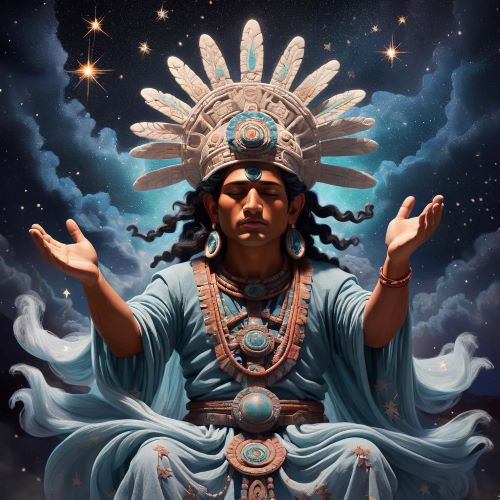Cocijo : God of Rain
Listen
At a glance
| Description | |
|---|---|
| Origin | Zapotec Mythology |
| Classification | Hybrids |
| Family Members | N/A |
| Region | Mexico |
| Associated With | Rain, Lightning |
Cocijo
Introduction
Cocijo stands as a central figure in Zapotec mythology, embodying the elemental forces of rain, thunder, and lightning. Revered by the Zapotec people of ancient Oaxaca, Mexico, Cocijo’s name itself is rooted in the Zapotec word for lightning, reflecting his deep connection to natural forces. More than just a weather deity, Cocijo was seen as a vital life-bringer whose presence ensured the prosperity of crops and the continuation of life. His worship spanned centuries—from the Preclassic period into the colonial era—signifying his enduring importance in Zapotec religious and agricultural life. Through rituals, ceremonies, and temple offerings, the Zapotec honored Cocijo as a protector, a creator, and a powerful divine force in their cosmos.
Physical Traits
Cocijo’s visual representation is a testament to his elemental power, blending attributes of animals sacred to Mesoamerican culture. He is typically portrayed with a hybrid face combining jaguar and serpent features. The jaguar, a symbol of strength and nocturnal power, and the serpent, associated with water and renewal, come together in Cocijo’s form to symbolize his dominion over both the skies and the earth. His snout resembles that of a jaguar, while his forked tongue echoes the crackling of lightning. Iconography often includes stepped motifs around his eyes, representing thunderclouds and celestial energy. The glyph “C,” representing water or rain, is commonly found in his headdress or as part of ceremonial masks, reinforcing his identity as the bearer of storms. These intricate visual codes formed a powerful symbolic language understood by ancient priests and communities alike.
Family
Although the Zapotec pantheon doesn’t outline a linear genealogy as seen in some other mythologies, Cocijo exists within a web of divine relationships that shaped Zapotec cosmology. He is often associated with a set of complementary gods who govern other aspects of nature and life. The goddess Nohuichaana, known as the creator of humankind, is often considered a maternal divine force and can be interpreted as a counterpart or cosmic origin to Cocijo’s role in sustaining life. Other gods in the pantheon, such as Coquihani, associated with light, and Cozobi, the maize god, share roles in maintaining agricultural balance, working alongside Cocijo to ensure cycles of planting and harvest. This network of deities illustrates a cosmology based on harmony, cooperation, and cyclical regeneration.
Other names
Over time and across regions, the name of Cocijo has been rendered in various forms, reflecting differences in dialect, orthography, and historical recording. Some sources refer to him as Cociyo, Gocio, or Loçio, while others use the indigenous Zapotec name Guziu. These variations not only mark linguistic diversity but also show how the deity’s worship adapted over generations and geographies. In colonial records, attempts to document Cocijo were often filtered through Spanish interpretations, leading to additional spelling discrepancies. Despite these changes, the core identity of Cocijo remained intact. His characteristics align closely with other Mesoamerican storm gods like Tlaloc of the Aztecs and Chaac of the Maya, suggesting a shared cultural reverence for rain deities across the region, each reflecting the deep reliance on agriculture and weather cycles.
Powers and Abilities
Cocijo’s powers are deeply rooted in the natural elements, especially those critical to agricultural societies. As the bringer of rain, he ensured that fields remained fertile and harvests abundant. His presence in the clouds, marked by rumbling thunder and flashing lightning, signaled his active role in nurturing the earth. According to Zapotec myths, Cocijo had the power to exhale the elements of creation—sun, moon, stars, land, rivers, and all living things—making him not just a weather god but a divine architect of the cosmos. He controlled the timing and intensity of the rains, balancing abundance with the threat of flood or drought. Rituals conducted in his honor often included offerings of food, copal incense, and, in more dire circumstances, human sacrifices—particularly children—who were believed to have a purer spiritual connection. These practices reveal the immense respect and fear Cocijo commanded in ancient times.
Modern Day Influence
Though the formal worship of Cocijo diminished following Spanish colonization, his essence continues to live on in both subtle and overt ways throughout contemporary Zapotec culture. In rural communities of Oaxaca, agricultural rituals still reflect an understanding of divine intervention in rainfall, and Cocijo remains a silent yet powerful presence in these ceremonies. His imagery endures in local art, from clay urns and murals to reinterpretations in contemporary paintings and sculpture. Museums like the Birmingham Museum of Art house artifacts that preserve his image, contributing to a broader global awareness of Zapotec heritage. During festivals, especially those tied to the planting season, elements of ancient rain-invoking traditions resurface in dances like the Danza de la Lluvia. Additionally, in the syncretic blend of Catholic and indigenous beliefs, Cocijo has often been associated with Christian saints such as St. James or St. John, whose feast days align with the rainy season. This blending allowed for the continuation of Cocijo’s veneration under new religious frameworks.
In modern political and cultural discourse, Cocijo has become a symbol of indigenous identity and resistance. In regions like Juchitán, where Zapotec traditions remain vibrant, invoking Cocijo signifies a return to ancestral knowledge and environmental respect. Even in branding—such as labels on artisanal mezcal—his name and imagery are used to emphasize heritage, strength, and authenticity. The themes central to Cocijo’s mythology—creation, duality, weather control, and ecological balance—continue to resonate as humanity grapples with climate change, sustainability, and cultural preservation.
Related Images
Source
De Cocijo al Rayo. Acercamiento etnohistórico a la ritualidad agrícola de los zapotecos del sur de Oaxaca. Retrieved from https://www.researchgate.net/publication/319700170_The_correlation_of_the_colonial_Northern_Zapotec_calendar_with_European_chronology
Ancient Zapotec Religion – University Press of Colorado (PDF). Retrieved from https://upcolorado.com/university-press-of-colorado/item/download/432_0f5ec1fefbe4dc4610499e89a8d45a60
COCIJO – the Zapotec God of Rain 🌧️ (Zapotec mythology). Retrieved from https://godchecker.com/zapotec-mythology/cocijo/
Cocijo – Wikipedia. Retrieved from https://en.wikipedia.org/wiki/Cocijo
Cocijo, Zapotec God of Rain & Lightning – Study.com. Retrieved from https://study.com/academy/lesson/cocijo-zapotec-god-of-rain-lightning.html
Zapotec Mythology: The Legend of the Rain God Cocijo. Retrieved from https://mexicohistorico.com/blog/zapotec-mythology-the-legend-of-the-rain-god-cocijo/
Cocijo – World History Encyclopedia. Retrieved from https://www.worldhistory.org/image/2129/cocijo/
Zapotec Gods | Religion, People & Temples – Study.com. Retrieved from https://study.com/academy/lesson/zapotec-gods-religion-people-temples.html
Introduction: The Origin and Development of Olmec Research. Retrieved from https://www.utpjournals.press/doi/pdf/10.3138/jcar.10.2.027
Frequently Asked Questions
What is lorem Ipsum?
I am text block. Click edit button to change this text. Lorem ipsum dolor sit amet, consectetur adipiscing elit. Ut elit tellus, luctus nec ullamcorper mattis, pulvinar dapibus leo.
What is lorem Ipsum?
I am text block. Click edit button to change this text. Lorem ipsum dolor sit amet, consectetur adipiscing elit. Ut elit tellus, luctus nec ullamcorper mattis, pulvinar dapibus leo.
What is lorem Ipsum?
I am text block. Click edit button to change this text. Lorem ipsum dolor sit amet, consectetur adipiscing elit. Ut elit tellus, luctus nec ullamcorper mattis, pulvinar dapibus leo.
What is lorem Ipsum?
I am text block. Click edit button to change this text. Lorem ipsum dolor sit amet, consectetur adipiscing elit. Ut elit tellus, luctus nec ullamcorper mattis, pulvinar dapibus leo.
What is lorem Ipsum?
I am text block. Click edit button to change this text. Lorem ipsum dolor sit amet, consectetur adipiscing elit. Ut elit tellus, luctus nec ullamcorper mattis, pulvinar dapibus leo.










